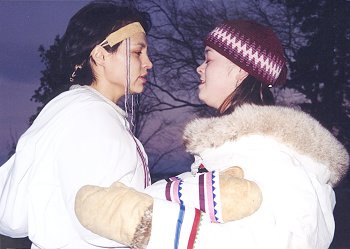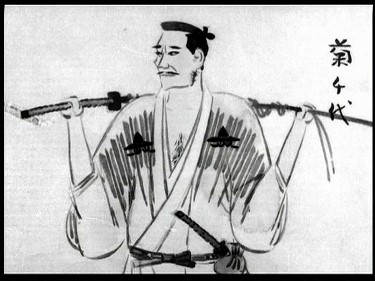Skip to comments.
Cavegirls were first blondes to have fun
London Times ^
| 2/26/06
| Roger Dobson and Abul Taher
Posted on 02/26/2006 11:56:29 AM PST by wagglebee
THE modern gentleman may prefer blondes. But new research has found that it was cavemen who were the first to be lured by flaxen locks.
According to the study, north European women evolved blonde hair and blue eyes at the end of the Ice Age to make them stand out from their rivals at a time of fierce competition for scarce males.
The study argues that blond hair originated in the region because of food shortages 10,000-11,000 years ago. Until then, humans had the dark brown hair and dark eyes that still dominate in the rest of the world. Almost the only sustenance in northern Europe came from roaming herds of mammoths, reindeer, bison and horses. Finding them required long, arduous hunting trips in which numerous males died, leading to a high ratio of surviving women to men.
Lighter hair colours, which started as rare mutations, became popular for breeding and numbers increased dramatically, according to the research, published under the aegis of the University of St Andrews.
“Human hair and eye colour are unusually diverse in northern and eastern Europe (and their) origin over a short span of evolutionary time indicates some kind of selection,” says the study by Peter Frost, a Canadian anthropologist. Frost adds that the high death rate among male hunters “increased the pressures of sexual selection on early European women, one possible outcome being an unusual complex of colour traits.”
Frost’s theory, to be published this week in Evolution and Human Behavior, the academic journal, was supported by Professor John Manning, a specialist in evolutionary psychology at the University of Central Lancashire. “Hair and eye colour tend to be uniform in many parts of the world, but in Europe there is a welter of variants,” he said. “The mate choice explanation now being put forward is, in my mind, close to being correct.”
Frost’s theory is also backed up by a separate scientific analysis of north European genes carried out at three Japanese universities, which has isolated the date of the genetic mutation that resulted in blond hair to about 11,000 years ago.
The hair colour gene MC1R has at least seven variants in Europe and the continent has an unusually wide range of hair and eye shades. In the rest of the world, dark hair and eyes are overwhelmingly dominant.
Just how such variety emerged over such a short period of time in one part of the world has long been a mystery. According to the new research, if the changes had occurred by the usual processes of evolution, they would have taken about 850,000 years. But modern humans, emigrating from Africa, reached Europe only 35,000-40,000 years ago.
Instead, Frost attributes the rapid evolution to how they gathered food. In Africa there was less dependence on animals and women were able to collect fruit for themselves. In Europe, by contrast, food gathering was almost exclusively a male hunter’s preserve. The retreating ice sheets left behind a landscape of fertile soil with plenty of grass and moss for herbivorous animals to eat, but few plants edible for humans. Women therefore took on jobs such as building shelters and making clothes while the men went on hunting trips, where the death rate was high.
The increase in competition for males led to rapid change as women struggled to evolve the most alluring qualities. Frost believes his theory is supported by studies which show blonde hair is an indicator for high oestrogen levels in women.
Jilly Cooper, 69, the author, described how in her blonde youth she had “certainly got more glances. I remember when I went to Majorca when I was 20, my bum was sore from getting pinched”.
However, Jodie Kidd, 27, the blonde model, disagrees with the theory: “I don’t think being blonde makes you more ripe for sexual activity. It’s much more to do with personality than what you look like. Beauty is much deeper than the colour of your hair.”
Film star blondes such as Marilyn Monroe, Brigitte Bardot, Sharon Stone and Scarlett Johansson are held up as ideals of feminine allure. However, the future of the blonde is uncertain.
A study by the World Health Organisation found that natural blonds are likely to be extinct within 200 years because there are too few people carrying the blond gene. According to the WHO study, the last natural blond is likely to be born in Finland during 2202.
TOPICS: Chit/Chat; History; Society
KEYWORDS: blondes; cavemen; collarandcuffs; ggg; godsgravesglyphs; helixmakemineadouble; iceage; svenska
Navigation: use the links below to view more comments.
first previous 1-20 ... 41-60, 61-80, 81-100 ... 141-159 next last
To: Darksheare
To: wagglebee
Well this would explain why I used to get run over for blondes *LOL*
62
posted on
02/26/2006 6:17:26 PM PST
by
cyborg
(I just love that man.)
To: wardaddy
Not everything is a conspiracy! Blondes will always be the best and most desired of women. Even in the Stone Age this was true apparently. I guess one could try to say something PC but that's not what I was thinking when I read the Sports Illustrated Swimsuit Issue.
63
posted on
02/26/2006 6:21:37 PM PST
by
cyborg
(I just love that man.)
To: Borax Queen
No habla espaniol. But I think you said, yes, you have been busy? lol
64
posted on
02/26/2006 6:21:37 PM PST
by
phantomworker
(It doesn’t matter what other people think or feel or say. “You are the only person who defines you.")
To: cyborg; wardaddy
"Not everything is a conspiracy!"
Correct, since once everyone gets on the same page, the need for one goes away.
65
posted on
02/26/2006 6:30:17 PM PST
by
gobucks
(Blissful Marriage: A result of a worldly husband's transformation into the Word's wife.)
To: phantomworker
Hahha, no, I *think* (hope) I said "now we are talking" about the men's pics.
To: Rushmore Rocks
Aleutes? Inuits?
Lots of vitamin D in marine fish oils and probaly marine-mammal blubber.These people live off the sea.
67
posted on
02/26/2006 6:39:11 PM PST
by
Hiddigeigei
(One doesn't have to regret the Enlightenment to be a conservative!)
To: JLS
You make an interesting point, but there's something you're missing. In much of Asia, the terrain is mountainous and the weather is as cold as in Europe or even more so, yet the people still have dark hair & eyes.
To: Rushmore Rocks
"Aleutes? Inuits?"And Eskimos.
Their diets were high in Vitamin D from eating seafood and the animals that ate seafood too. They didn't have to change color to get enough vitamin D.
Northern Chinese are lighter than southern Chinese and the Northern Chinese are descended from the Southern Chinese.
69
posted on
02/26/2006 6:43:32 PM PST
by
blam
To: Rushmore Rocks
Yup ~ light skin. No doubt you've seen such people after they've been out in the Sun. Take some time in the future and visit them in early March. Should be interesting to see what you have to do to get them to take off their coats.
There are many very light skinned Japanese, particularly among the higher nobility (all of whom no longer carry titles) but their families know who they are. Even Cherokee Indians have a substantial light skinned subset, as do other American Indians.
70
posted on
02/26/2006 6:46:58 PM PST
by
muawiyah
(-)
To: Lawgvr1955
The characteristic probably arose in less than 10 generations. I doubt it will die out quickly, although modern nutrition provides more vitamin D than was readily found in the past.
71
posted on
02/26/2006 6:48:41 PM PST
by
muawiyah
(-)
To: JLS
Brown "polar bears" are called Grizzly bears. For the most part they drowned in the cold water. Polar bears have many more adaptations than the pigmentation of their fur.
72
posted on
02/26/2006 6:50:16 PM PST
by
muawiyah
(-)
To: Borax Queen
Yeah, for reason, I like men's pics better. Two pics of the same guy, Kevin Costner. He is dreamy, isn't he? ;) Wish I had time to search the 'net for more sexy blonde guys before they become extinct! LOL!
73
posted on
02/26/2006 6:52:21 PM PST
by
phantomworker
(It doesn’t matter what other people think or feel or say. “You are the only person who defines you.")
To: wintertime
For example, a couple of Inuit women:

I didn't say they can't tan ~ they can ~ the Inuit have been living in the Polar regions for only a few thousand years ~ not at all like the Sa'ami ancestors of the Europeans who've been doing that for a few tens of thousands of years.
I can show you a few of those fellers who don't tan and can't imagine tanning.
74
posted on
02/26/2006 6:58:31 PM PST
by
muawiyah
(-)
To: wagglebee
Typical Inuit facial features are typical of those found in Japan.
For example:



75
posted on
02/26/2006 7:06:34 PM PST
by
muawiyah
(-)
To: Hiddigeigei
Note, living North of the 30th you really do have to eat a lot of fish ~ for one thing, cows can't live there.
At the same time your average human population that lives South of the 30th has an hereditary fish allergy 48% of the time.
Still, the amount of vitamin D you are going to get is less than you will need. It pays to have translucent skin, even if it tans in the Summer.
76
posted on
02/26/2006 7:11:10 PM PST
by
muawiyah
(-)
To: muawiyah; Clintonfatigued; Domestic Church; All
I agree with many of the fine points made by the people I pinged and others particularly about the oddity that the Inuits as a group seem to violat the furhter north the lighter rule, perhaps due to their diet being high in vitamine D.
In some ways I view this article as anthropromorphizing. These humans were just on the cusp of survival their entire lives. They likely were not all that picky about what they ate nor where they spread their seed. The latter being something many woman claim has not changed to this day.
I can offer an amusing alternative hypothesis to near starving, short life expectancy cave men perferring blonds, waiting around for a blond to walk by and risking not procreating. As we all know we fair skinned people do not run as fast, particularly in sprints, as our dark skinned brethren. So perhaps blonds were just slower and caught more freqently by all males? And that would explain all the dumb blond jokes as just a misunderstanding of slow and dumb someplace a few 1000 generations back?
77
posted on
02/26/2006 7:22:52 PM PST
by
JLS
To: muawiyah
Yes. But back to the original thesis of the article ... I suspect the caveman preferred the blond because she was healthy and didn't have rickets, rather than that she was sexy because she was a blue-eyed blond.
78
posted on
02/26/2006 7:23:43 PM PST
by
Hiddigeigei
(One doesn't have to regret the Enlightenment to be a conservative!)
To: wagglebee; arasina
79
posted on
02/26/2006 7:25:20 PM PST
by
Perdogg
("Facts are stupid things" - Pres. Ronald W. Reagan)
To: wagglebee
I would have liked the theory to also explain blondism among Australian aborigines, who are as far from Europe as you can get.
80
posted on
02/26/2006 7:26:12 PM PST
by
denydenydeny
("Osama... made the mistake of confusing media conventional wisdom with reality" (Mark Steyn))
Navigation: use the links below to view more comments.
first previous 1-20 ... 41-60, 61-80, 81-100 ... 141-159 next last
Disclaimer:
Opinions posted on Free Republic are those of the individual
posters and do not necessarily represent the opinion of Free Republic or its
management. All materials posted herein are protected by copyright law and the
exemption for fair use of copyrighted works.
FreeRepublic.com is powered by software copyright 2000-2008 John Robinson




